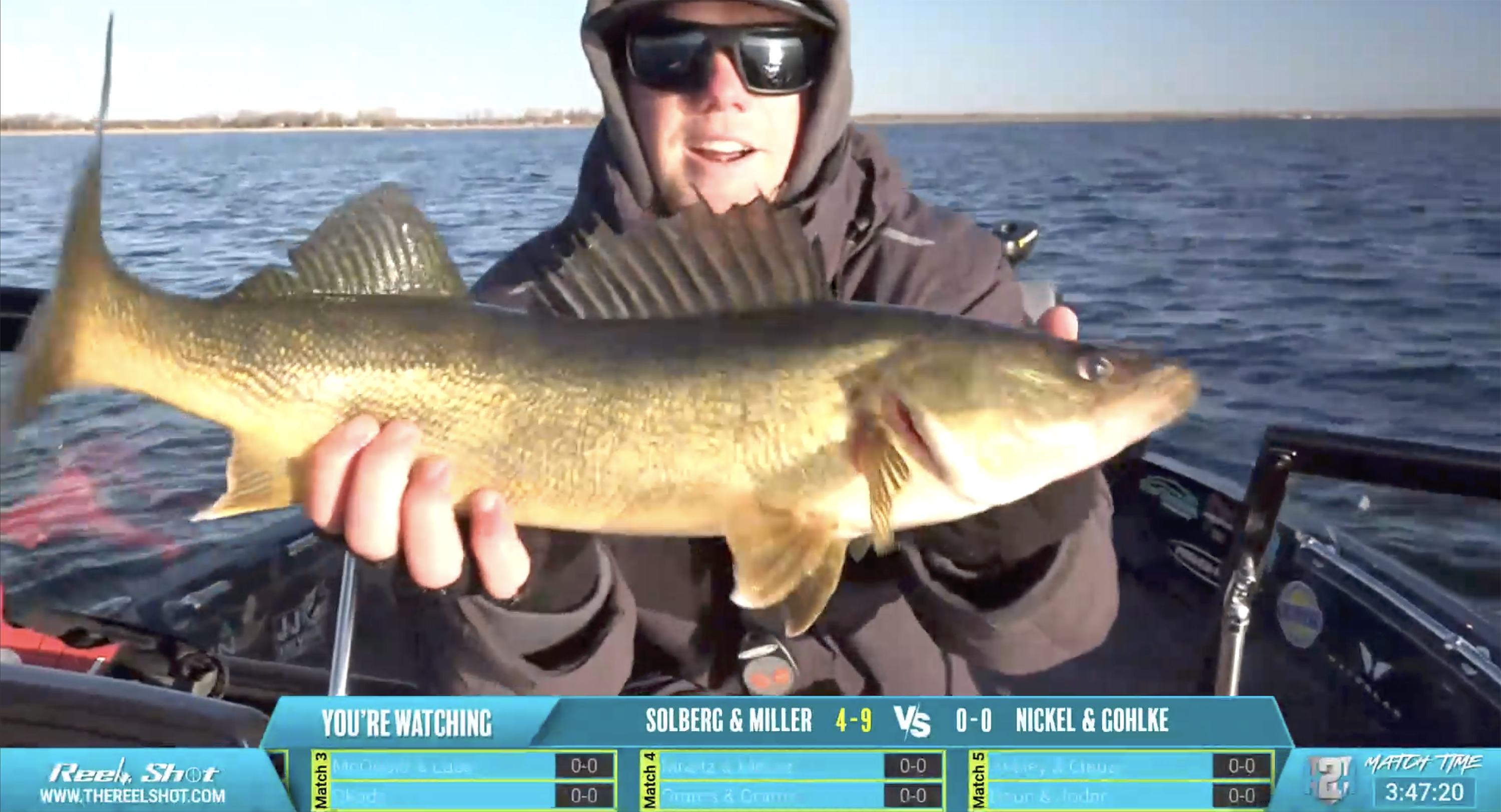news
SPOON FED WALLEYES
August 5, 2021 5:08 pm
Thanks to my tournament successes catching walleyes with jigging spoons, I can rarely do a fishing seminar without folks asking me to explain how to fish with a spoon.
Although the jigging spoon presentation may seem simple, there is a correct way to work a jigging spoon.
Jigging spoon color, style, weight, and design can make a difference, so choosing the right spoon for the body of water you are fishing is very important. I always want to try to match the forage that walleyes are feeding on, which is why color and size matter.
For example, most walleyes weighing five pounds or less prefer to eat 1-2 inch forage. So if that is the size fish you are targeting, staying with a spoon with that size profile is very important. However, if you are fishing the Great Lakes or other bodies of water with larger forage, then bumping the spoon up will put more fish in the boat.
I have fished, tried, and tested most of what is out there in the angling marketplace for jigging spoons for many years. When fish are aggressive, walleyes will hit most spoon designs if the overall length and profile come close to what they are eating. As we all know, however, walleyes can get pretty finicky at times, and it becomes critical to have the right spoon.
LURE CHOICE
My go-to spoon most of the time is the Hopkins Shorty in the hammered silver or gold weighing a quarter or half-ounce. I use silver in clear water and gold in dark or stained water to match the color of the forage fish. If small crappies or perch are the preferred forage, I will use a spoon with green tape; otherwise, I prefer a bare, non-painted, or taped spoon. Many painted or holographic spoon colors will work in certain lakes. The standard colors and adjusting to a local lake color are what I prefer.
If the forage is longer than an inch or two, I will fish the no-equal in those same two colors. I also like to use the no-equal when pitching in weed pockets as they do not get hung up as often as the shorty.
If the forage is smelt, alewives, cisco, chubs, or fishing for trophy walleyes, I will increase the size of the spoon to match. Of course, I must then make some changes in the tackle, which I will explain later. Shop Cast Champ Spoons.


TACKLE
Whether casting and retrieving or vertical jigging with spoons, I always use 10 or 12 pound-test monofilament. While fishing spoons, I prefer the lines that are on the stiff side. I seldom use braided lines with jigging spoons because it changes the presentation, and I get way fewer strikes with braids compared to mono.
I also attach a crankbait snap to the line instead of tying directly. The quick-snap allows the spoon to flutter and dive like an injured minnow, and this lets me make quick changes in size or color if I want.
Fishing with a medium to a medium-heavy rod that is six and a half feet or longer and a spinning reel is my preference when using the lighter spoons. When I go with the larger, heavier spoons, I switch to a baitcasting combo and sometimes bump my line test up to a 14-pound test.
PRESENTATION
My favorite presentation is casting spoons along sharp-breaking shorelines or sand cuts as well as weed edges. I do this by positioning the boat at an angle towards the edge of a break. This position allows me to work the spoon from shallow to deep. When fishing the bait, I am popping the rod tip and then allowing it to fall to the bottom before repeating the process until the spoon is to the back of the boat.
Sometimes walleyes will follow the spoon to the boat, so I always vertical jig it a few times just in case. I have caught a surprising number of fish right at the boat doing this. I also like to allow the spoon to sit on the bottom for a few seconds before snapping the rod tip, as walleyes often grab the jigging spoon while it is lying still.
I also vertical jig with a spoon, especially when fish are in deep water on a hump or along with a sharp break. Again, I will pop the spoon off of the bottom about two feet and allow it to flutter back to the bottom, allowing it to sit for a few seconds before repeating the presentation. Vertical jigging is best if you can drift an edge or work it with your trolling motor.
TROUBLESHOOTING
Northern pike will often eat jigging spoons and can be a real bother when fishing this presentation for walleyes. If a pike bite is present, I will attach the spoon to a thin wire leader to prevent bite-offs. Although, I prefer not to add a leader because it changes the spoon action. The action changes due to the swivel on the leader, but that is better than having a dozen or more spoons end up in the stomachs of hungry northern.

Line twists can be a problem when vertical jigging. If line twists happen, a barrel swivel attached a foot above the spoon will alleviate that problem. That said, I still prefer not to add the swivel because it takes away some of the natural flutters of the spoons.
Instead, I will suspend the spoon above the bottom or make a few long casts with it to unravel any line twist.
Sometimes walleyes can be found in wood or stumps in deep water. If you want to fish this type of structure or thick weeds, try replacing the treble hook with a single to eliminate snags. You will get snagged less often if you use a wire hook, and you should be able to pull out of most of the stumps. This situation is also one of the times I will switch to braid to prevent break-offs.
TIPPING THE SPOON
Tipping the spoon with live bait might be a good idea when ice fishing (in fact, I recommend it), but it is a terrible idea when fishing open water. Here is why: any live bait, piece of plastic, or any other dressing will cause the spoon to parachute, which is not a natural presentation. The whole idea of the spoon is to make it look as natural as possible, and you are already doing that with your fluttering presentation. The design of the spoon is doing the rest for you.
Adding live bait will not improve your presentation. The opposite is true because you will catch fewer fish if you catch any at all!
WHAT FISH SEE
Walleyes see jigging spoons as an injured baitfish and will readily grab it. When minnows are dying, they flutter to the bottom and lay on their sides, just like the spoon. It is a very natural presentation to the fish. Also, placing a stick-on eye above the hook will encourage them to grab there instead of the top. Spoons also kick up dirt and dust off the bottom, attracting predator fish.
I have fished spoons in lakes across North America and caught walleyes, panfish, and smallmouth, spotted, and largemouth bass in just about every one of those lakes. I have caught fish in 3 feet of water and 75 feet of water and every depth in between.


I have won over $100,000 in tournament competitions using only spoons. I have had them work on days when nothing else is going on. I find them especially deadly from post-spawn to freeze-up in the North and all winter long in the South. Sometimes jigging spoons are the only way to go during cold fronts and clear water conditions.
PRACTICE, PRACTICE, PRACTICE
Like any presentation, practice makes perfect. One of the reasons why so many anglers try fishing with jigging spoons and fail is that they give up on the spoon way too soon. I didn’t learn the idiosyncrasies of the jigging spoon presentations overnight, and neither will you. First of all, increase your odds by choosing a lake with lots of walleyes. Start with a quarter-ounce spoon in silver or gold. Stay away from weeds, wood, and big rocks to minimize the frustration and fish for walleyes with the spoons over sand or gravel ledges or humps. Once you gain confidence, you can move into scattered weeds or weed edges, rock and wood, and begin experimenting with colors and size.









